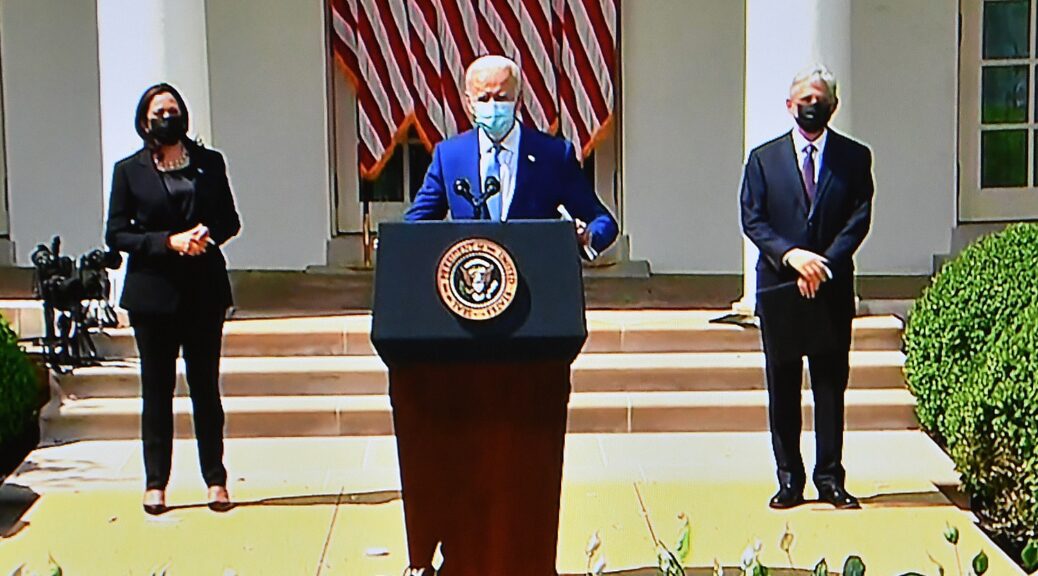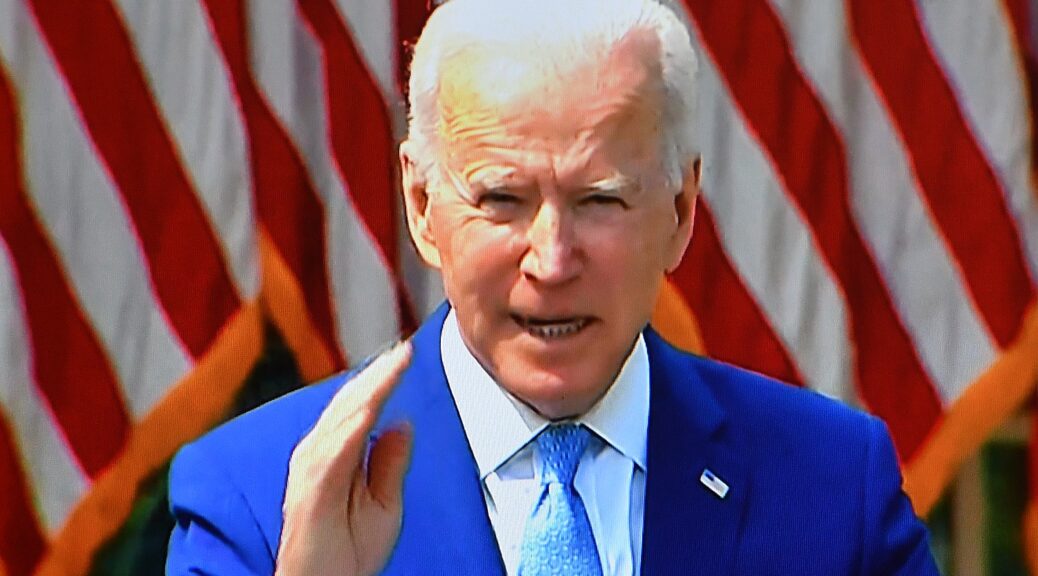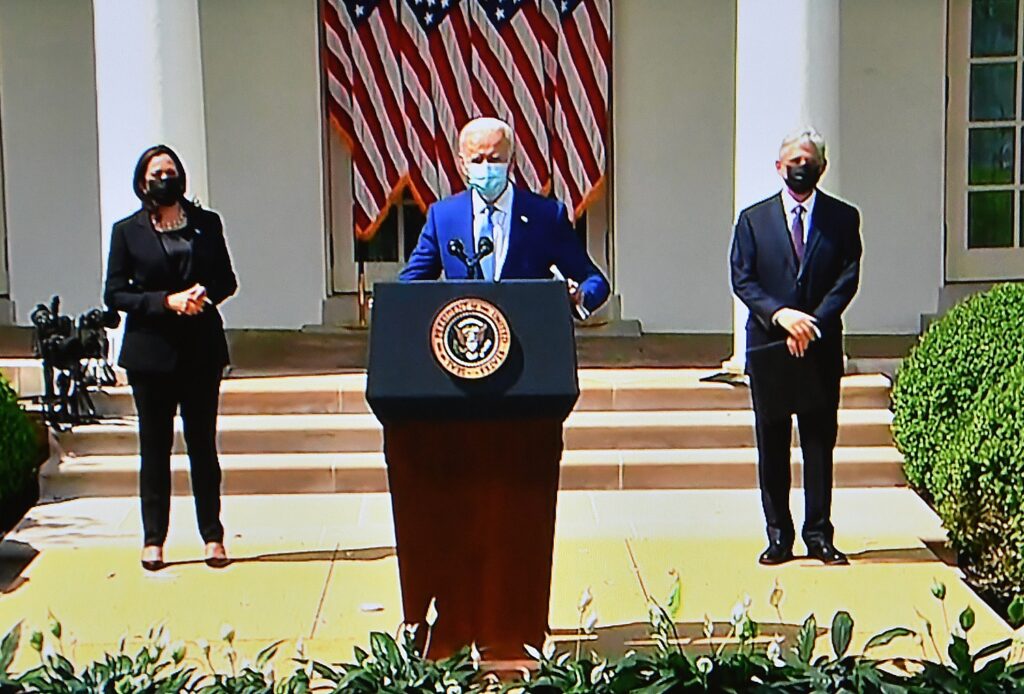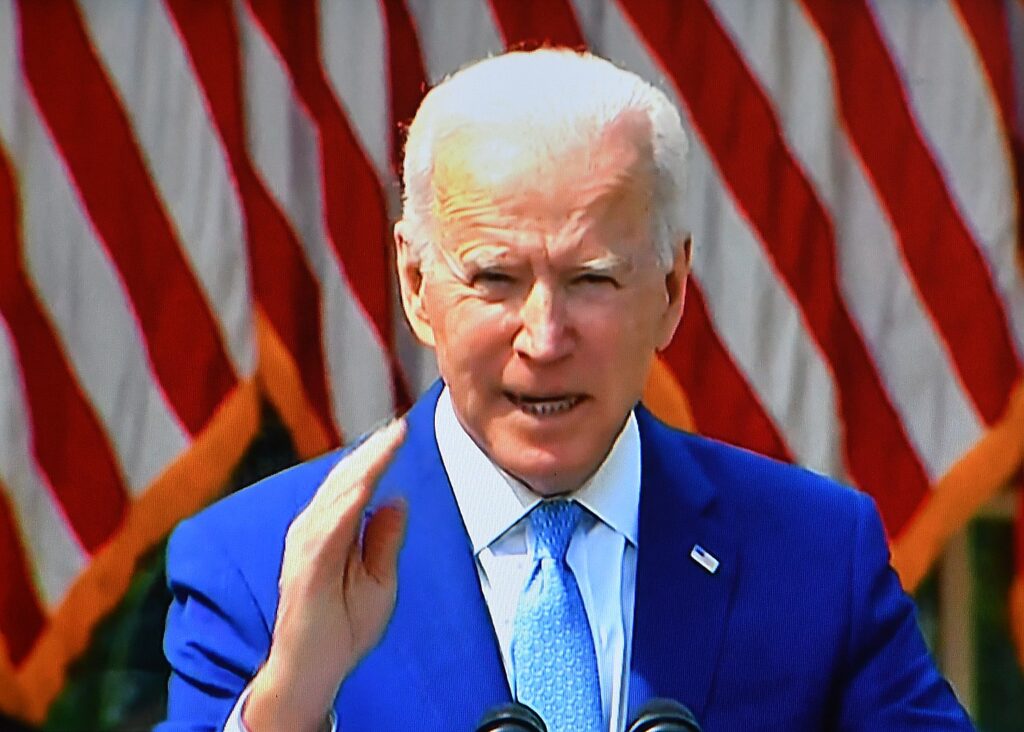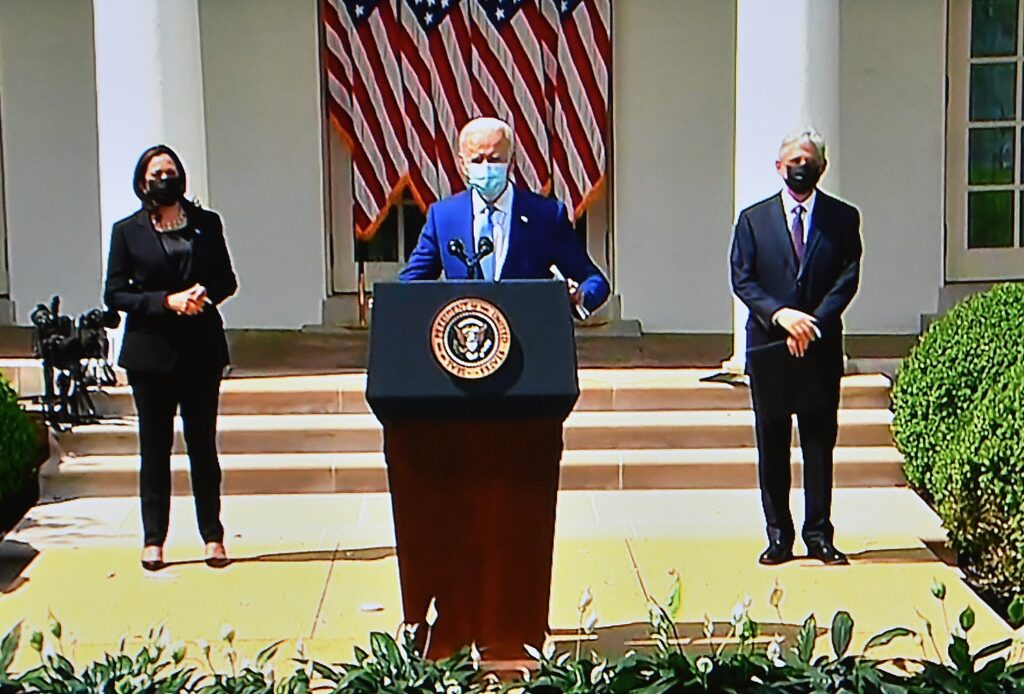
The White House issued fact sheets detailing the executive actions the Biden Administration announced on April 7 to address the gun violence, along with a whole-of-government response to the public health epidemic of gun violence, including regulating ghost guns, pistols enhanced with braces, incentivizing states to implement Red Flag laws, and launching community-based anti-violence programs. At the same time, President Joe Biden called upon Congress to pass universal background checks, ending gun manufacturers’ immunity, and issuing a new ban on assault weapons and high-capacity ammunition.
The recent high-profile mass shootings in Boulder – taking the lives of 10 individuals – and Atlanta – taking the lives of eight individuals, including six Asian American women – underscored the relentlessness of this epidemic. Gun violence takes lives and leaves a lasting legacy of trauma in communities every single day in this country, even when it is not on the nightly news. In fact, cities across the country are in the midst of a historic spike in homicides, violence that disproportionately impacts Black and brown Americans. The President is committed to taking action to reduce all forms of gun violence – community violence, mass shootings, domestic violence, and suicide by firearm and detailed a whole-of-government response.
Meanwhile, President Biden reiterated his call for Congress to pass legislation to reduce gun violence. Last month, a bipartisan coalition in the House passed two bills to close loopholes in the gun background check system. Congress should close those loopholes and go further, including by closing “boyfriend” and stalking loopholes that currently allow people found by the courts to be abusers to possess firearms, banning assault weapons and high capacity magazines, repealing gun manufacturers’ immunity from liability, and investing in evidence-based community violence interventions. Congress should also pass an appropriate national “red flag” law, as well as legislation incentivizing states to pass “red flag” laws of their own.
“But this Administration will not wait for Congress to act to take its own steps – fully within the Administration’s authority and the Second Amendment – to save lives.” The Administration announced the following six initial actions:
The Justice Department, within 30 days, will issue a proposed rule to help stop the proliferation of “ghost guns.” We are experiencing a growing problem: criminals are buying kits containing nearly all of the components and directions for finishing a firearm within as little as 30 minutes and using these firearms to commit crimes. When these firearms turn up at crime scenes, they often cannot be traced by law enforcement due to the lack of a serial number. The Justice Department will issue a proposed rule to help stop the proliferation of these firearms.
The Justice Department, within 60 days, will issue a proposed rule to make clear when a device marketed as a stabilizing brace effectively turns a pistol into a short-barreled rifle subject to the requirements of the National Firearms Act. The alleged shooter in the Boulder tragedy last month appears to have used a pistol with an arm brace, which can make a firearm more stable and accurate while still being concealable.
The Justice Department, within 60 days, will publish model “red flag” legislation for states. Red flag laws allow family members or law enforcement to petition for a court order temporarily barring people in crisis from accessing firearms if they present a danger to themselves or others. The President urges Congress to pass an appropriate national “red flag” law, as well as legislation incentivizing states to pass “red flag” laws of their own. In the interim, the Justice Department’s published model legislation will make it easier for states that want to adopt red flag laws to do so.
The Administration is investing in evidence-based community violence interventions. Community violence interventions are proven strategies for reducing gun violence in urban communities through tools other than incarceration. Because cities across the country are experiencing a historic spike in homicides, the Biden-Harris Administration is taking a number of steps to prioritize investment in community violence interventions.
- The American Jobs Plan proposes a $5 billion investment over eight years to support community violence intervention programs. A key part of community violence intervention strategies is to help connect individuals to job training and job opportunities.
- The U.S. Department of Health and Human Services is organizing a webinar and toolkit to educate states on how they can use Medicaid to reimburse certain community violence intervention programs, like Hospital-Based Violence Interventions.
- Five federal agencies are making changes to 26 different programs to direct vital support to community violence intervention programs as quickly as possible. These changes mean we can start increasing investments in community violence interventions as we wait on Congress to appropriate additional funds.
The Justice Department will issue an annual report on firearms trafficking. In 2000, the Bureau of Alcohol, Tobacco, and Firearms (ATF) issued a report summarizing information regarding its investigations into firearms trafficking, which is one way firearms are diverted into the illegal market where they can easily end up in the hands of dangerous individuals. Since the report’s publication, states, local, and federal policymakers have relied on its data to better thwart the common channels of firearms trafficking. But there is good reason to believe that firearms trafficking channels have changed since 2000, for example due to the emergence of online sales and proliferation of “ghost guns.” The Justice Department will issue a new, comprehensive report on firearms trafficking and annual updates necessary to give policymakers the information they need to help address firearms trafficking today.
The President will nominate David Chipman to serve as Director of the Bureau of Alcohol, Tobacco, and Firearms. ATF is the key agency enforcing our gun laws, and it needs a confirmed director in order to do the job to the best of its ability. But ATF has not had a confirmed director since 2015. Chipman served at ATF for 25 years and now works to advance commonsense gun safety laws.
Details on the Biden-Harris Administration’s Investments in Community Violence Interventions
Cities across the country are experiencing a historic spike in homicides, violence that is greatest in racially segregated, high-poverty neighborhoods. Black men make up 6% of the population but over 50% of gun homicide victims. Black women, Latinos, and Native Americans are also disproportionately impacted. The loss of life has devasting consequences for family members and cascading harms for communities. As just one example, research shows that exposure to firearm violence—including as a victim or witness—makes it twice as likely an adolescent will commit a violent act within two years.
But there is reason to be optimistic. We know that a relatively small number of people are involved in urban gun violence, whether as perpetrators or victims. There are proven community violence intervention (CVI) strategies for reducing gun violence through tools other than incarceration. For example, violence interruption programs deploy trusted messengers work directly with individuals most likely to commit gun violence, intervene in conflicts, and connect people to social and economic services to reduce the likelihood of gun violence as an answer. Hospital-based violence interventions engage people who have been shot while they are still in the hospital, connecting them to services to decrease the likelihood that they commit gun violence or are victimized in the future. Programs like these have reduced homicides by as much as 60% in areas where they are implemented.
To date, CVI programs have been badly underfunded, even though the economic consequences of gun violence are staggering. One study calculates that gun violence costs America $280 billion annually. For fraction of that cost, we can save lives, create safe and healthy communities, and build an economy that works for all of us.
As part of a package of initial actions to reduce gun violence, the Biden-Harris Administration announces historic investments in community violence intervention to combat the gun violence epidemic.
American Jobs Plan: President Biden’s American Jobs Plan, unveiled last week, calls on Congress to invest $5 billion over eight years to support evidence-based community violence intervention programs that train at-risk individuals for jobs and provide other wraparound services to prevent violence and assist victims. These strategies will help rebuild economies in the hardest hit areas.
Medicaid Funding: The U.S. Department of Health and Human Services is organizing a webinar and toolkit to educate states on how they can use Medicaid to reimburse certain community violence intervention programs, like Hospital-Based Violence Interventions
Leveraging Existing Grant Programs: Five agencies are making changes to existing federal funding streams across 26 programs to direct vital support to CVI programs quickly as possible. For example:
- The Department of Justice will give priority to applicants proposing CVI strategies in its Comprehensive Youth Violence Prevention and Reductions Programs, a $11 million competitive grant that provides funding for programs that prevent and reduce youth violence. The solicitation will post by the end of April 2021 and awards will be made by September 30, 2021.
- The Department of Justice will develop guidance to clarify that states can use their allocations from annual Victims of Crime Act (VOCA) funding—including over $1 billion in FY21—for CVI efforts and will provide training and technical assistance on CVI to grantees.
- The National Institutes of Health will prioritize community-based intervention research for its Firearm Injury and Mortality Prevention Research grant awards. These programs will provide $12.5 million to improve understanding of the determinants of firearm injury, those most at risk (including both victims and perpetrators), and strategies to prevent firearm injury and mortality. Applications are due April 30, 2021, with awards expected in September 2021.
Full List of Agency Actions
Department of Justice
- DOJ will place a special emphasis on CVI in its FY21 Edward Byrne Memorial Justice Assistance Grant (JAG) program, a $484 million formula grant that is the leading federal source of criminal justice funding to states, territories, local governments, and Tribes. The solicitation will post by June 1, 2021 and the awards will be made by September 30, 2021. In addition, DOJ will highlight CVI in its National Training and Technical Assistance Center (NTTAC) website.
- DOJ will issue guidance to raise awareness that the $18.9 million under its FY21 Byrne Criminal Justice Innovation (BCJI) program is available to support CVI efforts. This solicitation was posted on January 11, 2021, and its deadlines are April 26, 2021 on Grants.gov and May 10, 2021 on JustGrants.
- DOJ will include CVI as a topic area in its FY21 Community Policing Development (CPD) Micro-Grants, a $3 million program that supports innovative community policing strategies. The solicitation will be posted by April 15, 2021 and awards will be made by September 30, 2021.
- DOJ will make CVI a priority focus area in its FY21 Cops Hiring Program, a $156 million competitive grant program that funds entry-level law enforcement officers. Law enforcement agencies that partner with community organizations to implement community violence intervention strategies will receive preference points in the scoring of applications. The solicitation will be posted by the end of April 2021 and awards will be made by September 30, 2021.
- DOJ will give priority to applicants proposing CVI strategies in its FY21 Smart Policing program, which provides $8 million in funding, training, and technical assistance for law enforcement to use data and technology to respond to crime. The solicitation will post by April 30, 2021 and awards will be made by September 30, 2021.
- DOJ will issue guidance to clarify that community-based organizations with CVI proposals are eligible for the $12.75 million Second Chance Act Community-Based Reentry Program. This solicitation was posted on January 14, 2021, and its deadlines are April 13, 2021 on Grants.gov and April 27, 2021 on JustGrants.
- DOJ will make clear to all judicial districts that they can support CVI programs through Project Safe Neighborhoods (PSN) funding and technical assistance. PSN is designed to make neighborhoods safer through a sustained reduction in violent crime. The solicitation will post by April 30, 2021 and the awards will be made by September 30, 2021.
- DOJ will support CVI through its FY21 Strategies to Support Children Exposed to Violence program, a $7 million program that provides funding, training, and technical assistance to communities to address children’s exposure to violence and prevent gun violence. Priority will be given to CVI applicants and technical assistance providers addressing youth violence. The solicitation will post by the end of April 2021 and awards will be made by September 30, 2021.
- DOJ will give priority to CVI applicants in its Comprehensive Youth Violence Prevention and Reductions Programs, a $11 million competitive grant that funds youth violence prevention and reduction. The solicitation will post by the end of April 2021 and awards will be made by September 30, 2021.
- DOJ will continue to uplift CVI programs via webinars and trainings through the National Gang Center. The National Gang Center will expand its outreach efforts to interested communities about evidence-based models, such as the Comprehensive Gang Model that includes street outreach and violence interrupters.
- DOJ will support CVI in its FY21 School Violence Prevention Program (SVPP), a $53 million competitive grant program that funds equipment, technology, and training to address school violence. Applicants that have experienced high rates of gun violence will receive priority, with an emphasis on wraparound services for students most likely to engage in or be victimized by gun violence. The solicitation will be posted by April 15, 2021 and awards will be made by September 30, 2021.
- DOJ will support CVI through its FY21 Hospital-Based Victim Services program, a $2 million funding stream for programs that link the victim services field and medical facilities. The solicitation will post by the end of April 2021 and the awards will be made by September 30, 2021.
- DOJ will support CVI through the Office for Victims of Crime’s (OVC) new Center for Culturally Responsive Victim Services program, which will provide $3 million to an organization to launch a national resource to improve trauma-informed, victim-centered services in communities of color. The solicitation will post by the end of April 2021 and the award will be made by September 30, 2021.
- DOJ OVC will release guidance to clarify that the Victims of Crime Act (VOCA) Victim Assistance Rule does not prevent states from using VOCA funding—over $1 billion in FY21—for CVI efforts. The guidance will also inform states that funding CVI programs is a means to meet VOCA’s requirement that 10% of funds go toward serving underserved communities. In addition, OVC’s Training and Technical Center (OVC TTAC) and its new Center for VOCA Administrators (VOCA Center) will to provide assistance around CVI strategies.
Department of Health and Human Services
- The National Institutes of Health published two opportunities for Firearm Injury and Mortality Prevention Research in March, PAR-21-191 and PAR-21-192. These programs will provide $12.5 million to improve understanding of the determinants of firearm injury, those most at risk, and interventions that prevent firearm injury and mortality. For grant applications with comparable scientific merit, NIH will prioritize applications about CVI. Applications are due April 30, 2021, with awards expected in September 2021.
- The Centers for Disease Control and Prevention (CDC) published a notice of funding opportunity in March for Preventing Violence Affecting Young Lives (PREVAYL), a program that addresses violence impacting adolescent and young adults. CDC anticipates awarding $10 million over 5 years. CDC will highlight CVI strategies in an April 8 informational call, through guidance, and on its website. Applications are due May 1, 2021, with awards expected by August 2021.
- CDC has an open funding opportunity announcement for its National Centers of Excellence in Youth Violence Prevention (Youth Violence Prevention Centers or YVPCs) program, which builds the evidence base for strategies like CVI that reduce rates of youth violence within geographic communities. CDC anticipates awarding $30 million over 5 years. Applications are due April 21, 2021, with awards expected in September.
Department of Housing and Urban Development
- HUD will encourage applicants for the FY21 Choice Neighborhoods Initiative, a $200 million competitive place-based grant program that transforms underserved neighborhoods, to include CVI as part of their overall public safety strategy to reduce crime. HUD will discuss the importance of CVI in the notice of funding announcement and in grantee resources.
- HUD will encourage grantees of Community Development Block Grant – CV Funds (CDBG-CV), who received a special appropriation of $5 billion through the CARES Act, to use part of their allocations to support CVI efforts needed to combat violence as a result of the coronavirus pandemic. HUD will publish a guide by June that explains how CVI activities can use CDBG funds, which will also apply to annual formula CDBG funds—approximately $3.4 billion per year.
Department of Education
- ED will issue guidance on how grantees can use 21st Century Learning Centers (21st CCLC) funds to support children impacted by trauma and reengage disconnected youth. 21st CCLC provides $1.26 billion for community learning centers with after-school and summer programs for students in high-poverty and underperforming schools. New awards will be made July 1, 2021.
- ED will support states and school districts in investing Student Support and Academic Enrichment (SSAE) funds toward CVI activities via a guidance document and technical assistance. SSAE is a $1.22 billion program that boosts academic achievement by improving learning conditions. New awards will be made July 1, 2021.
- ED will launch a new competition in FY22 for Project Prevent, an $11 million program that helps schools increase their capacity to identify and serve students who have been exposed to pervasive violence by expanding access to counseling and conflict-resolution strategies.
- ED will incentivize applicants to use CVI-focused strategies in two grant competitions for FY22: Full Service Community Schools and Promise Neighborhoods. Full-Service Community Schools supports partnerships between schools and community-based organizations to offer academic and social services for students in high-poverty communities. Promise Neighborhoods supports coordinated community pipeline services to improve educational outcomes in the most underserved neighborhoods.
Department of Labor
- DOL will issue guidance to state and local workforce agencies and nonprofits under its Workforce Innovation and Opportunity Act (WIOA) programs, encouraging grantees to incorporate CVI into their activities. WIOA provides $3.5 billion in formula and discretionary grants to support employment and training programs for low-income adults, disadvantaged youth, and dislocated workers. YouthBuild, a WIOA discretionary program, provides $89 million annually for pre-apprenticeship programs for at-risk youth, including youth who are formerly incarcerated.
DOL will make CVI an allowable grant activity in Program Year 2021 (July 2021-June 2022) for its Young Adult Reentry Partnership grants, $25 million for organizations providing education and employment training to young adults who left high school before graduation or have had justice system involvement. The grants prepare participants who reside in high-poverty and high-crime communities—those disproportionately impacted by gun violence—for stable, quality employment. The funding opportunity announcement will be posted in early 2022.

